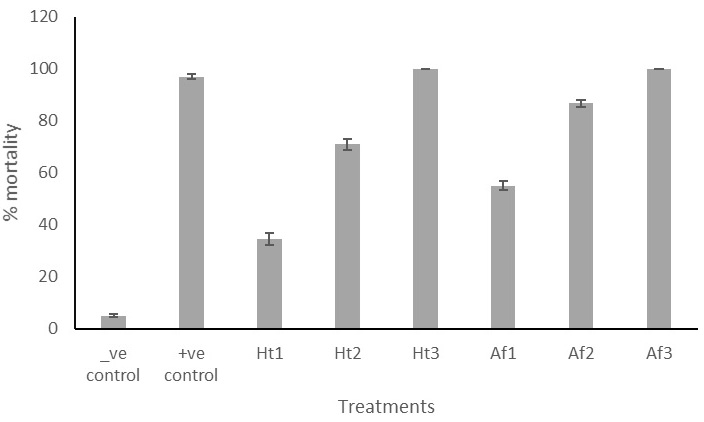Acetylcholinesterase Inhibitory Activity of Venom of Hottentota tamulus (Fabricius) and Androctonus finitimus (Pocock) (Scorpiones: Buthidae) in Musca domestica
Acetylcholinesterase Inhibitory Activity of Venom of Hottentota tamulus (Fabricius) and Androctonus finitimus (Pocock) (Scorpiones: Buthidae) in Musca domestica
Naila Riaz1, Hafiz Muhammad Tahir2, Muhammad Khalid Mukhtar1, Ali Hassan2, Shaukat Ali2, Shafaat Yar Khan1
Scorpion species used in the study. A: Androctonus finitimus and B: Hottentota tamulus.
Peptide fractions of scorpion species (A= Hottentota tamulus and B= Androctonus finitimus) were separated by HPLC.
Comparison of mean percentage mortality rate in M. domestica adults caused by specific doses of selected scorpion species venom peptides and Chlorpyrifos. *(-ve control= Water, +ve control= Chlorpyrifos, Ht1= 10µg/ml of H. tamulus venom peptide, Ht2= 20µg/ml of H. tamulus venom peptide, Ht3= 30µg/ml of H. tamulus venom peptide, Af1= 10µg/ml of A. finitimus venom peptide, Af2= 20µg/ml of A. finitimus venom peptide and Af3= 30µg/ml of A. finitimus venom peptide). * Data represented as Mean± SEM.
Comparison of AChE activity (Optical density) in M. domestica adults caused by specific doses of selected scorpion species venom peptides and Chlorpyrifos. (-ve control= Water, +ve control= Chlorpyrifos, Ht1= 10µg/ml of H. tamulus venom peptide, Ht2= 20µg/ml of H. tamulus venom peptide, Ht3= 30µg/ml of H. tamulus venom peptide, Af1= 10µg/ml of A. finitimus venom peptide, Af2= 20µg/ml of A. finitimus venom peptide and Af3= 30µg/ml of A. finitimus venom peptide). Different alphabets indicates the significant difference between the different groups, same alphabet indicates non-significant difference in the groups. Optical density was recorded with absorbance at wavelength of 412nm












